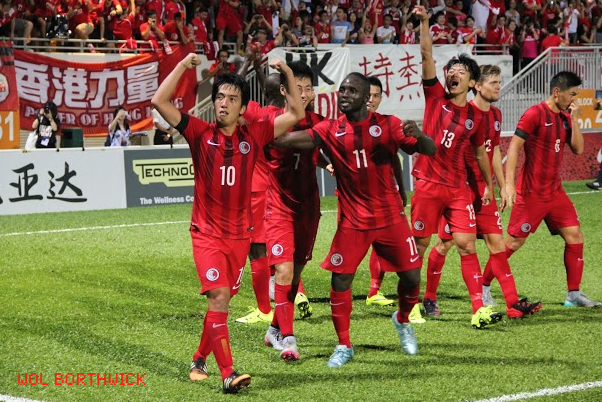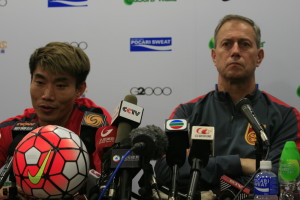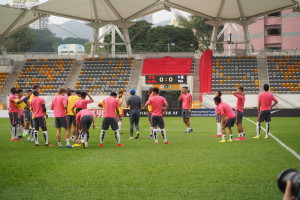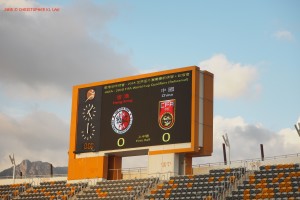Wild East Football’s JRP Borthwick assesses the mood before Hong Kong’s most important international game in history – a massive clash against PR China…
On Tuesday 17 November Hong Kong will face China in a vital 2018 World Cup qualifying fixture at the city’s Mong Kok Stadium. What is being described in football circles as the city’s biggest match in decades will be played in front of a crowd of just 6,000 fans, leaving tens of thousands of unlucky supporters to make other plans to view the clash, one which is expected to come dripping in passion from start to finish. A confluence of events over the last 12 or so months all but guarantees that tensions will be at peak levels for the match.
This time last year large parts of the city were in traffic lock down as students led political protests in the form of Occupy Central and the Umbrella Revolution against Beijing and proposed electoral reforms.
More recently, at the start of China’s qualification campaign, the Chinese FA released a poster that riled local Hong Kong fans. Some described the poster as bizarre while at the other end of the spectrum it was seen as xenophobic towards some members of the team, a group of players reflective of the multiculturalism of Hong Kong as a whole.
With the mercury rising between Beijing and Hong Kongers, on both the sporting and also political fronts, it was seen manifesting itself at HK international football fixtures as the the crowd at home games began to boo the Chinese national anthem, The March of the Volunteers, as it was played before kick-off.
The mixing of politics and sport was made furthermore clear as quite often during these matches one could observe in the crowd fans sporting yellow umbrellas, the symbol of 2014’s long-running street protests against the Beijing authorities.
As one can imagine, the booing didn’t go down well in some circles. Protests were made to the footballing authorities and eventually the HKFA was fined by FIFA in early October, fearing at one point that harsher punishment would be dealt, such as having to play games behind closed doors.
The cumulative impact of these factors, as well as Hong Kong’s strong performances in the group, has seen interest in this game reach levels not seen in a football match in the territory for decades and it is the fact that the game has ended up at the normally-adequate Mong Kok Stadium that has Hong Kong’s conspiracy theorists hitting overdrive. Why is a game of such importance and with such widespread interest not being played at the city’s primary stadium, the 40,000-seater Hong Kong Stadium?
The reason given by the Hong Kong Government’s Leisure and Cultural Services Department was that the pitch would not have had a suitable period of time to recover following a two-day – Saturday 7th and Sunday 8th November – Asian qualification event for rugby 7s at the Olympics in Rio next year. Some Hong Kongers are suspicious. Was the forced venue selection engineered as a result of the actions of the boo boys at the earlier home fixtures?
HK’s football hierarchy was also baffled. HKFA CEO Mark Sutcliff, in his blog on 26th October (in the lead up to the rugby event) wrote “I have worked in sport for over 30 years and I simply don’t understand why a new, high specification pitch cannot support 2 days of rugby 7s (which is nowhere near as damaging as 15 a-side rugby) and then be ready again to play a football match 9 days later.” Writing again in the same blog on Monday 9th, the day following the 7s qualification event, Mr Sutcliffe stated that he had visited the pitch and found a pitch in a worse state than he could have imagined. He questioned “how is it possible to spend 7 months and HK$100m and still end up with a pitch that is virtually unplayable”?
Indeed, how!? A number of football grounds were used in the recent 2015 Rugby World Cup (RWC) including Manchester City Stadium (Man City), Elland Road (Leeds United), St James’ Park (Newcastle United) and Villa Park (Aston Villa). These pitches were not put out of commission for football use due to the RWC matches. St James’ Park, for example, hosted New Zealand vs Tonga on the evening of 9 October and then, the very next day, 10 October, Samoa vs Scotland. Two RWC clashes involving a combined total of 160 minutes of heavyweight rucking, mauling and scrummaging. This is some of the harshest treatment and heaviest wear that a sporting field could ever be asked to endure. 8 days later, on Sunday October 18th, fans at St James’ witnessed Newcastle beat Norwich 6 – 2 in their English Premier League clash.
Whichever way you look at it, this situation is not good and should have been avoidable. It is a massive loss to HK’s committed football fans and those that had formerly been on the fence about local football but had started to show interest as a result of this match and this qualification campaign. The game will be riddled with both political and sporting intrigue and it is a real shame that just 6,000 will be able to enjoy it live, as it could have been another major milestone in the further development of interest in local football.
At the same time perhaps there will eventually be some answers as to why HKD 100 million could apparently be spent on nothing…
All pictures from Chris KL Lau and WOL Borthwick
JRP Borthwick is a part-time football photographer and full time football fan. JB grew up in Hong Kong and has fond memories of playing football here during his youth – from the potato patch that Happy Valley used to be, to playing in Aberdeen in the shadow (and the strong odour) of the BAT factory building. JB is committed to promoting the quality of both local football support and participation. When not playing, supporting or photographing footy, JB promotes his charity (The Wellbeing Society), writes children’s books and works in business development.




Guozu should wrap this one up easily, but I really hope they bottle it and HK grab second spot.
CFA have really shown themselves to be a bunch of cucking funts.
Ha! Can’t score in a brothel.
Oh yes. Sack Perrin!
Congratulations to Hong Kong. You guys did a great job for holding off China.